The Old Room is a Palace was Jaehun's first solo exhibition, held last summer in a studio apartment in Yongin-si, Gyeonggi-do, South Korea. Most of the works exhibited were made using photographic prints as the main material, incorporating the furniture and surplus spaces within the officetel. (For example, the exhibition's namesake work, The Old Room is a Palace, was created by flipping over a wardrobe and attaching a single photograph to its back.) The eight works created in this way were displayed and then deinstalled during the exhibition's ten-day run.
I, who created those works and that exhibition, continued to think about them even after the exhibition ended. I did so repeatedly. When you repeat the same memory, the residues of the present often accumulate within it, creating a space larger than the actual event. As the resident of said space, a presence unseen but felt, I intend through this essay to take out the photograph forming The Old Room is a Palace from among the various objects within it, and examine it together.
Just as the seeds of memory must travel towards those who will welcome them, a photograph named The Countenance of an Old Beauty in this essay will be separated from the work and the exhibition, and placed alongside three other photographs that are externally similar to it.
(1) A photograph of British suffragette Emmeline Pankhurst (1858-1928), presumed to have been taken when she was first imprisoned for obstructing public duty.
(2) A photograph by American photographer Sally Mann (1951-) of her daughter during several summers spent with her family in a rural cabin.
(3) A self-portrait taken by American artist and stylist Fern Cerezo (1994-) in a studio, dressed as a star.
These three photographs were created under different historical backgrounds and personal needs, but they are similar in that they bear witness to people who have broadened the intersection between the two words, 'woman' and 'freedom'. I would be delighted if this essay, which inscribes my photograph into a corner of that alliance, could be read as a guide to The Old Room is a Palace and a small history of women.
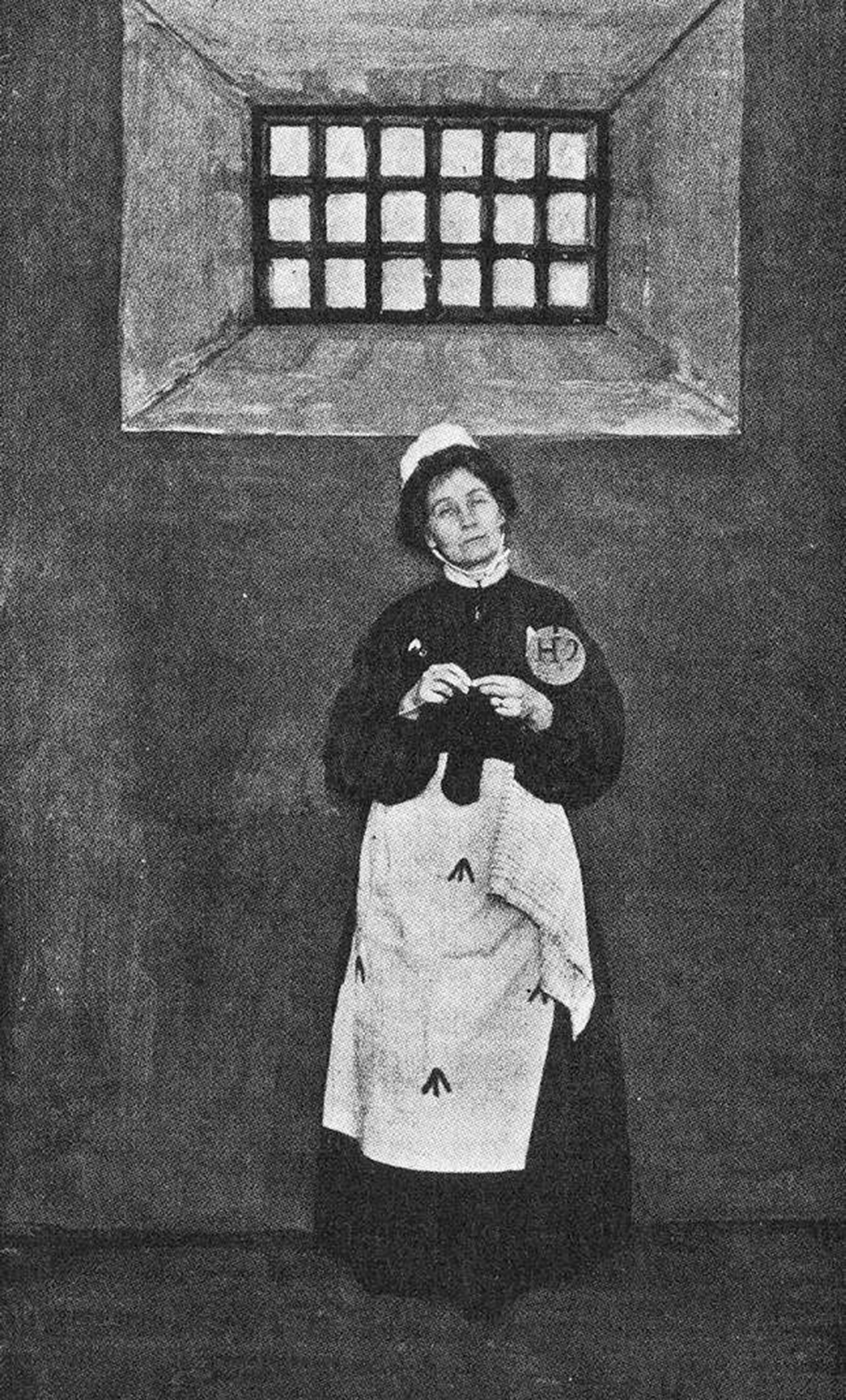
The Suffragette, Sturgis & Walton Company, 1911, p.330
The year 1918 was when women in the United Kingdom were first able to exercise limited voting rights. Before then, the right to vote was guaranteed only to men with specific professions or a certain level of property. It was not until 1928, with the enactment of the Representation of the People (Equal Franchise) Act, that all adults aged 21 and over were granted equal voting rights regardless of gender – something that happened less than 100 years ago.This change was not a footprint of progress that naturally occurred as the civic consciousness of male bureaucrats grew. It was a victory shrewdly fought for and won by countless women's suffrage activists who recognized a future with guaranteed women's suffrage as a historical inevitability.
Emmeline Pankhurst (1858-1928), who appears in the photograph above, is a representative British suffragette. Entering the women's suffrage movement at the age of 14, she joined and left various activist organizations, from the Women's Franchise League to the Independent Labour Party, continually pondering the most effective methods to achieve her goal of 'securing women's right to vote.' As a result of this reflection, the Women's Social and Political Union (WSPU), which she founded in 1903, carried out militant demonstrations under the slogan 'Deeds, not Words.' They threw stones to shatter public building windows, detonated bombs in post boxes, slashed paintings displayed in museums with knives, and even threw themselves in front of the King's horse in the middle of a racecourse.
The WSPU and other suffragettes did not resort to militant methods from the outset. Approximately 40 years before the WSPU's direct actions intensified in 1908, Civil society activists and organizations like the London Society for Women's Suffrage attempted to achieve their goals through legal means such as petitions, signature campaigns, rallies, and lectures. However, their petitions were ignored and not treated as important agenda items in the British House of Commons. Even the WSPU's activism, for the first five years after its establishment, respected legal boundaries. But the result was still disregarded. Furthermore, in a protest against the government's thorough disregard, Emmeline was arrested and imprisoned on charges of obstructing a police officer's duties even before entering the House of Commons. This incident prompted the WSPU to formalize their methods of activism, pressuring the government to choose between women's freedom and women's death.
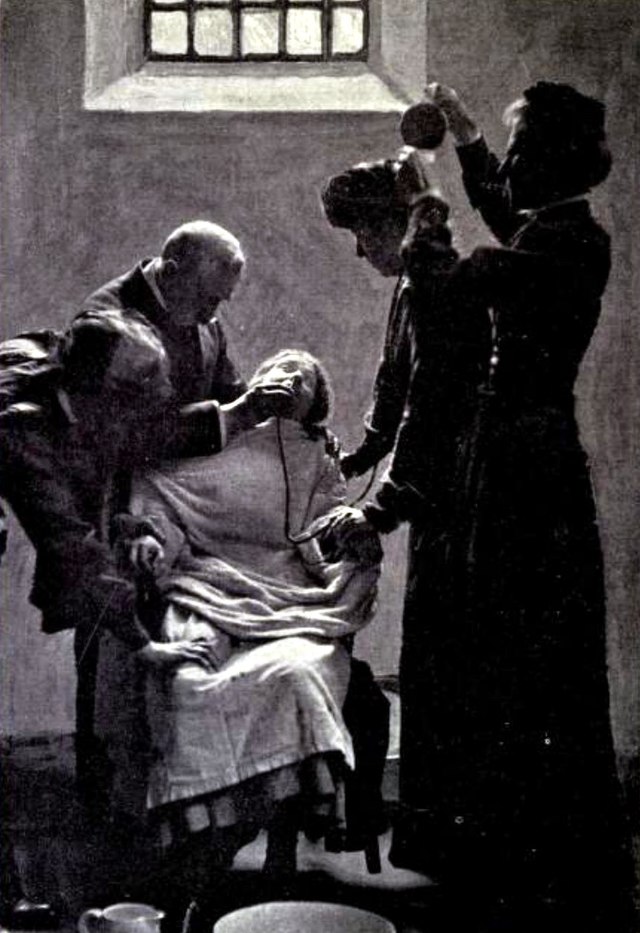
Women who participated in militant demonstrations were often arrested by the police and sent to prison. So many went that a culture emerged of giving flowers to activists who were released after their first imprisonment as a form of encouragement. However, women did not agree with their imprisonment by a government that did not recognize them as citizens. Hunger strikes in prison became a primary way for women to express their disobedience and protest, with countless women refusing food until they were on the brink of starvation. And the government forcibly fed these women who sought to uphold their will in this manner.
Their limbs were restrained, their tightly shut mouths were forced open with gags, and food was spoon-fed, or a liquid mixture of milk, eggs, and broth was injected into their nostrils via tubes. These inhumane forced feedings took place one after another in the solitary cells where the prisoners were held, and each time their fierce resistance and screams echoed through the prison. This horrific scene, repeated more than twice a day, became a physical and mental trauma for many women. All this violence was the price that the demand "As a human being, as a citizen, a woman also wants to vote" had to bear, and it happened just a little over 100 years ago.
In the photograph 'Emmeline Pankhurst in prison,' she appears to be waiting for someone, or perhaps pausing for a photograph, or enduring the present to meet the next phase of her life and society. As if responding to that wait, approximately 100 years after this photo was taken, a film titled 'Suffragette' was released, based on her autobiography, "My Own Story." In the film, Maud Watts, a 17-year veteran laundry worker and 24-year-old woman, asks her husband a question during her journey of understanding the meaning of women not having the right to vote: "If I had a daughter (instead of a son), what kind of life would she live?" Her husband replies, “She'd live the same life as you.”
This answer, which vividly proclaimed the despairing future awaiting women at that time, became a strong motivation for her to identify herself as a suffragette thereafter. Watching the film, empathizing with Maud, one of many (yet mostly ordinary) suffragettes, I found myself wondering: Wasn't the resolute fighting spirit shown by Emmeline and other women activists also necessary, like Maud, to help their own children – their future selves?
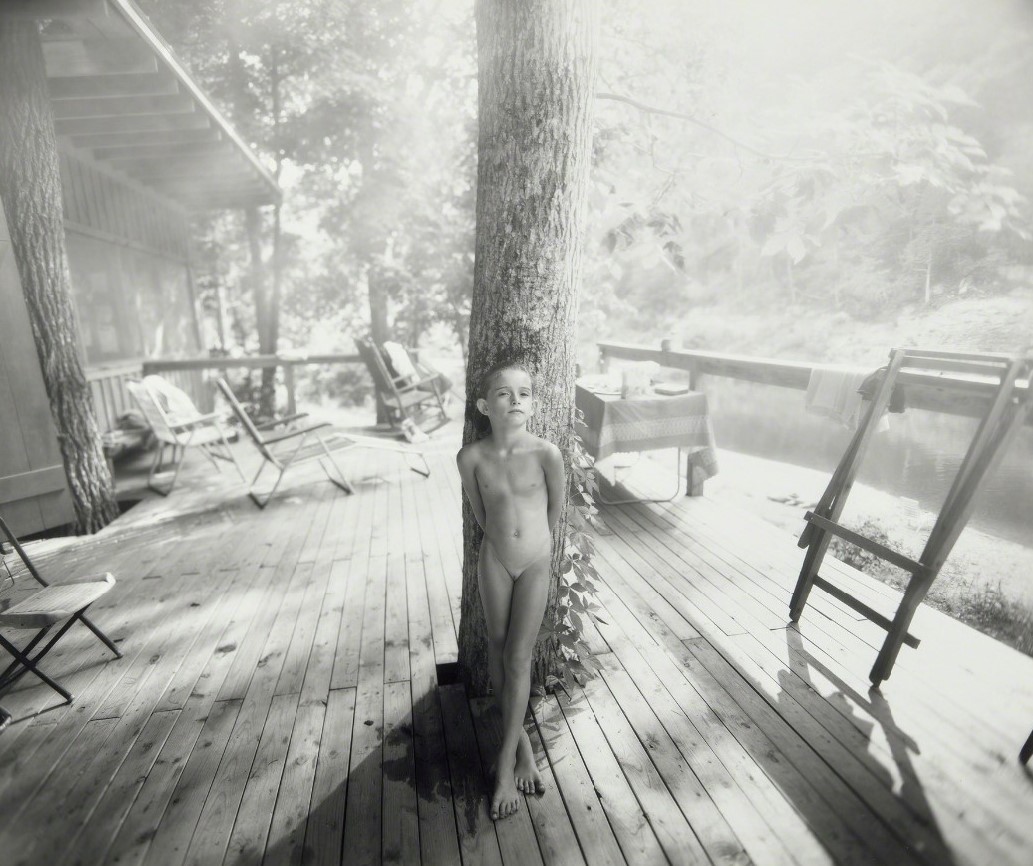
Ⓒ Sally Mann
Sally Mann (1951-), a photographer, was born in Virginia, USA, about a generation after Emmeline's death. Sally's sensitivity and values, which Emmeline and other feminists expanded upon, were greatly influenced by her father, Robert Munger, a physician and art enthusiast. Robert would read his favorite books to young Sally, take her photographs (as an amateur photographer), and even gave her her first camera. Soon after receiving the camera, Sally fell in love with photography. Robert fully supported her passion for art, which led her to study photography and art in college before slowly building her career as a photographer in the field.
Immediate Family, which includes Jessie at 6, is her third photography book. Between 1984 and 1991, Sally photographed her three children, Virginia, Jessie, and Emmett, while staying with her own family at a summer cottage in the foothills of Virginia. For Sally, who had always had a camera with her since childhood, and for her family, photography was as natural as a gentle breeze. The photographs in Immediate Family, a product of that breeze, candidly capture the relaxed atmosphere one would expect in a pastoral setting, children playing in nature, and the everyday family incidents and accidents that occurred in between.
However, this candidness plunged Sally Mann into a major controversy. She was widely criticized for allegedly sexually objectifying children for commercial gain, simply because 13 out of the total 63 photographs in Immediate Family included her children's naked bodies. Raymond Sokolov of the Wall Street Journal cropped only the naked body of then four-year-old Virginia in one photo, covering her eyes, breasts, and genitals with black boxes to present it as typical obscenity.1 Richard B. Woodward of The New York Times worried whether Sally had knowingly put her children at risk by publicizing their nude photographs in a world where pedophilia exists.2
Even setting aside the argument that Sally's photographs are obscene, the criticism that they endanger children is quite compelling. When I first saw her photographs, I felt both their beauty and a sense of concern. The child in the photograph doesn't know what a woman is, doesn't know what a photograph is, and doesn't know how a woman's body circulates among men. Shortly after the photographs were published, Sally received over 300 print orders within a year, amounting to approximately 1.5 million dollars in today's value. Who can definitively deny that one of the factors making her photographs appealing is the taboo of 'child nudity' included in them?
Sally, aware of this point, reportedly intended to publish her children's photographs not immediately after shooting them, but 10 years later (when the children could make more mature judgments). However, Emmett and Jessie were angry about this unilateral decision to delay publication. Having enjoyed the process of ordinary photography as much as Sally, it seems they felt hurt that she hadn't consulted them about publicizing the results. In response, Sally sought the opinion of a psychologist to accurately understand how her children felt about the photographs of themselves, and discussed what her children in the future might think of these photos. They talked about how their perspective on these photographs might change when they had their first partner, married a kindred spirit, and had children of their own. The publication of Immediate Family in 1992 was a decision made after such deliberation. The significance of this choice, before discussing its rightness or wrongness, lies in the fact that the self-determination of Emmett, Jessie, and Virginia (three children whose combined age was less than 30) was respected to the greatest extent possible throughout the process.
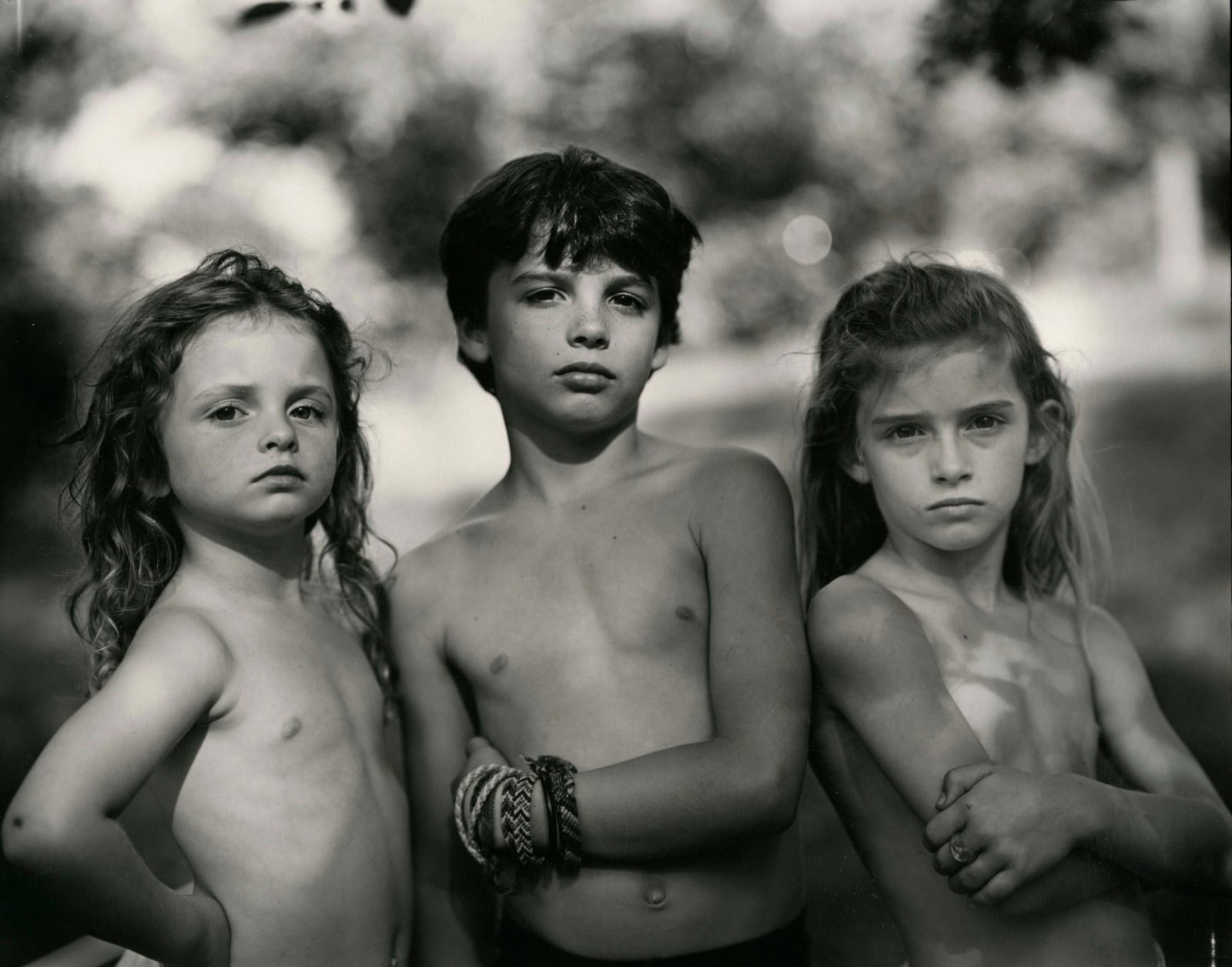
Ⓒ Sally Mann
When asked, "How much do your photographs reflect your children's real lives?", Sally once gave an interesting answer: “Perhaps I am photographing my own past (by taking pictures of my children). Because I have so few memories of my own childhood, I remember it through the photographs my father took of me.”3 Hearing this, it feels as if Sally photographing her children is her inheriting the habit her father had of photographing her as a child. If I were to rephrase this impression using Sally's own words, it would be:
“I will help my children inherit my idiosyncrasy, just as I successfully inherited my parents' idiosyncrasy – perhaps, taking photographs of their children. I hope you, too, will live out your way, without doubt.”4
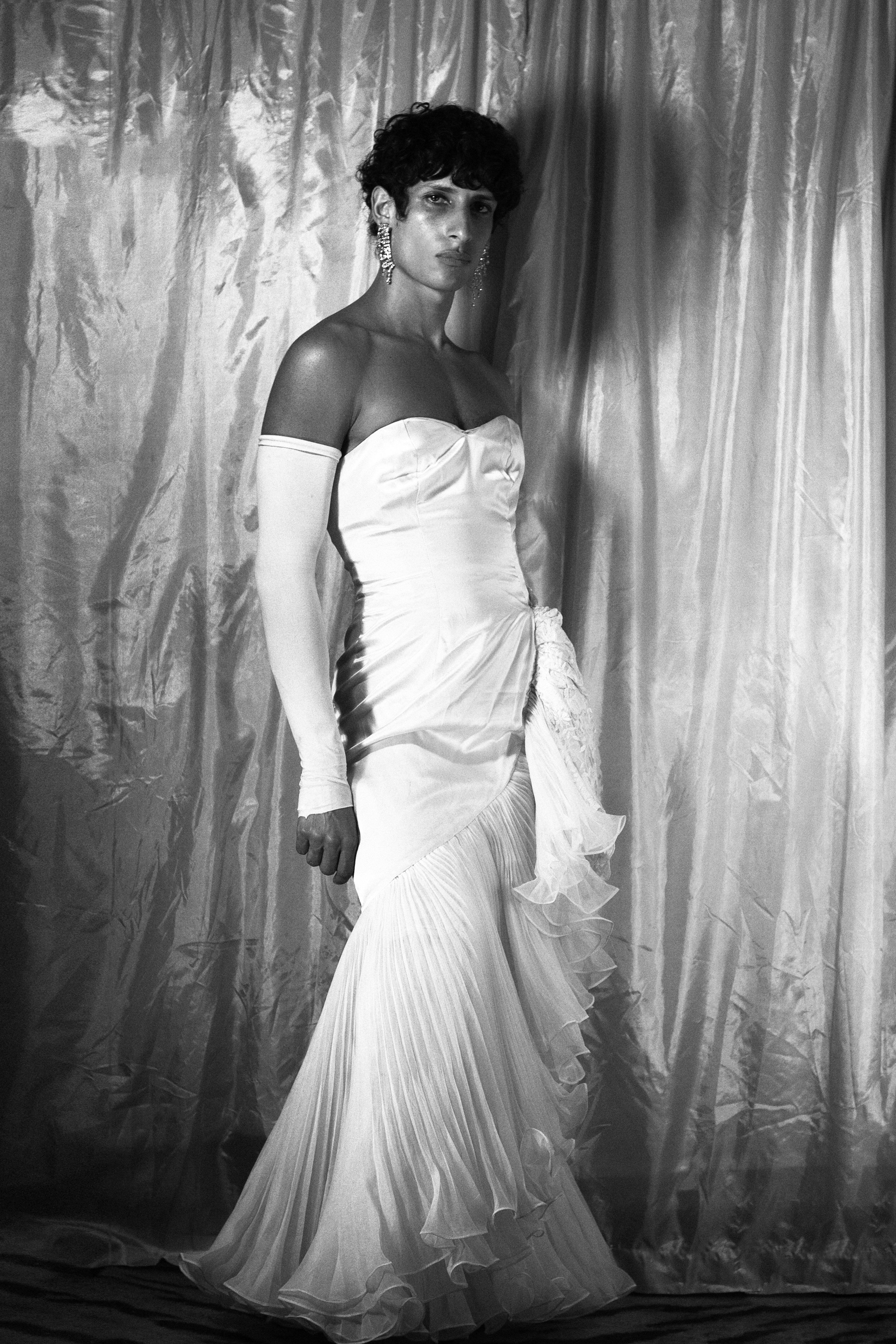
Ⓒ Fern Cerezo
If Jessie at 6 is a collaboration between Sally and her daughter Jessie, then Fern Cerezo's (1994~) self-portrait Premiere is a result of Fern's sole efforts in directing, photographing, and modeling. In this photograph, Fern appears to be someone who profoundly understands what photography is, how a woman is a cultural concept shaped by specific choices, and how to realize their own desires. This is because the model's desired self-identity is powerfully presented within the rectangular frame.
By wearing a wedding dress, traditionally reserved for heterosexual brides, a body assigned male at birth reveals their desired gender identity or sexuality. Beneath this expression lies a resolute will to achieve happiness (by transitioning to the next stage of life). Fern refers to themself in this photo as a 'star - the protagonist of their own life' and adds the following about image and power:
"The star gazes with knowing, confronting the camera as a worthy adversary. If the ingenue is told who to be, the star decides for themself.
(...)
Public perceptions held against the body will always be there, haunting but why not reclaim dominance over our image by showing the world how to look at us? The star dares to become the protagonist of their own life, taking their place in the center, right where the light hits."5
From the above statement, we can clearly hear a demand for agency over one's body and destiny. Fern states that they used photography as a means to access “magical connection to their body when dancing or having sex, and to feel that emotion without a dancefloor or a lover.”6 Therefore, Premiere must be a work where Fern asserts their body, reinterpreted from the violence of the symbolic world through inner dialogue with themself, using the language of photography. In that sense, this work feels to me almost like the courage of an adult Jessie deciding to reveal her bare self from Jessie at 6 to the public again, even without her mother Sally.
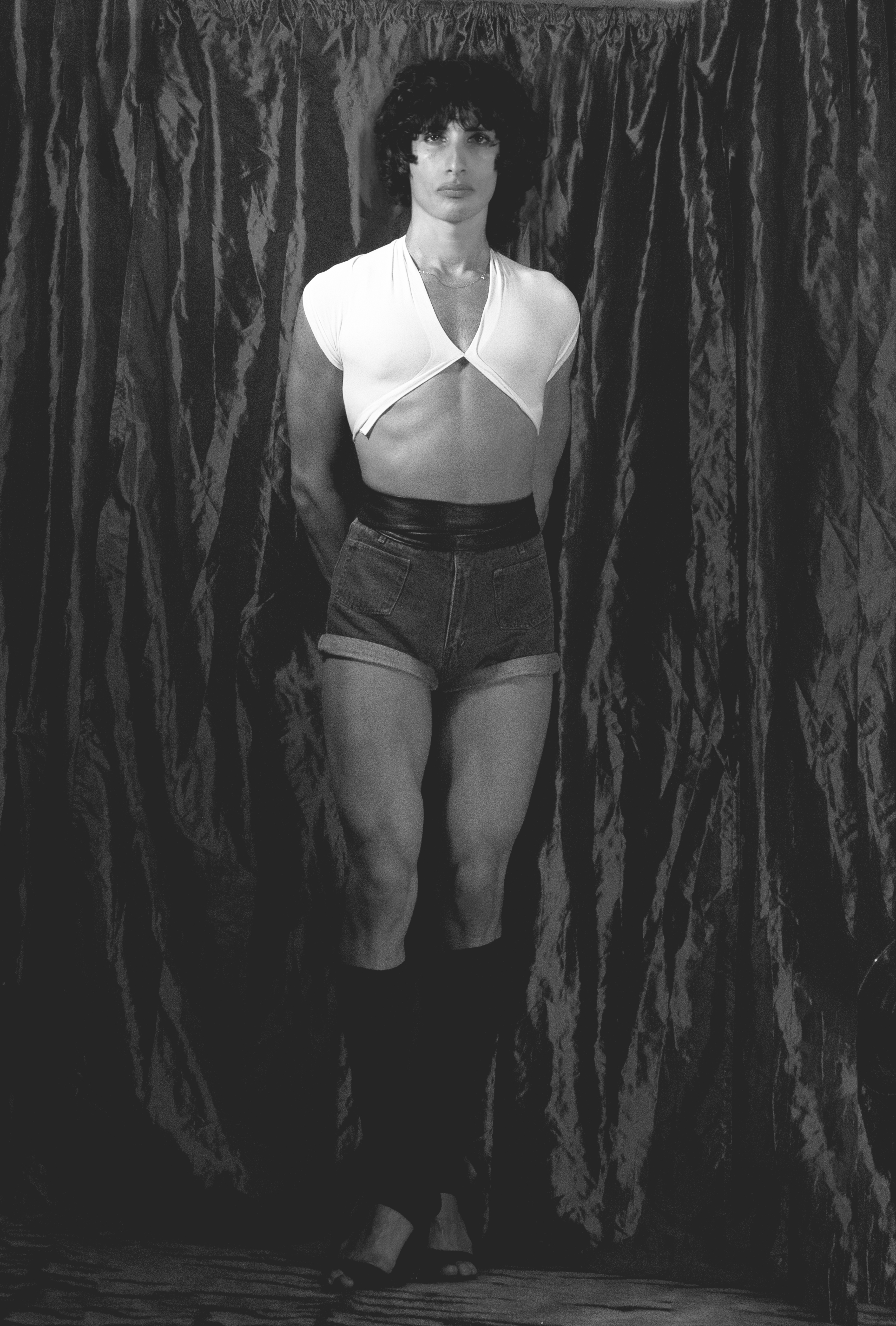
Ⓒ Fern Cerezo
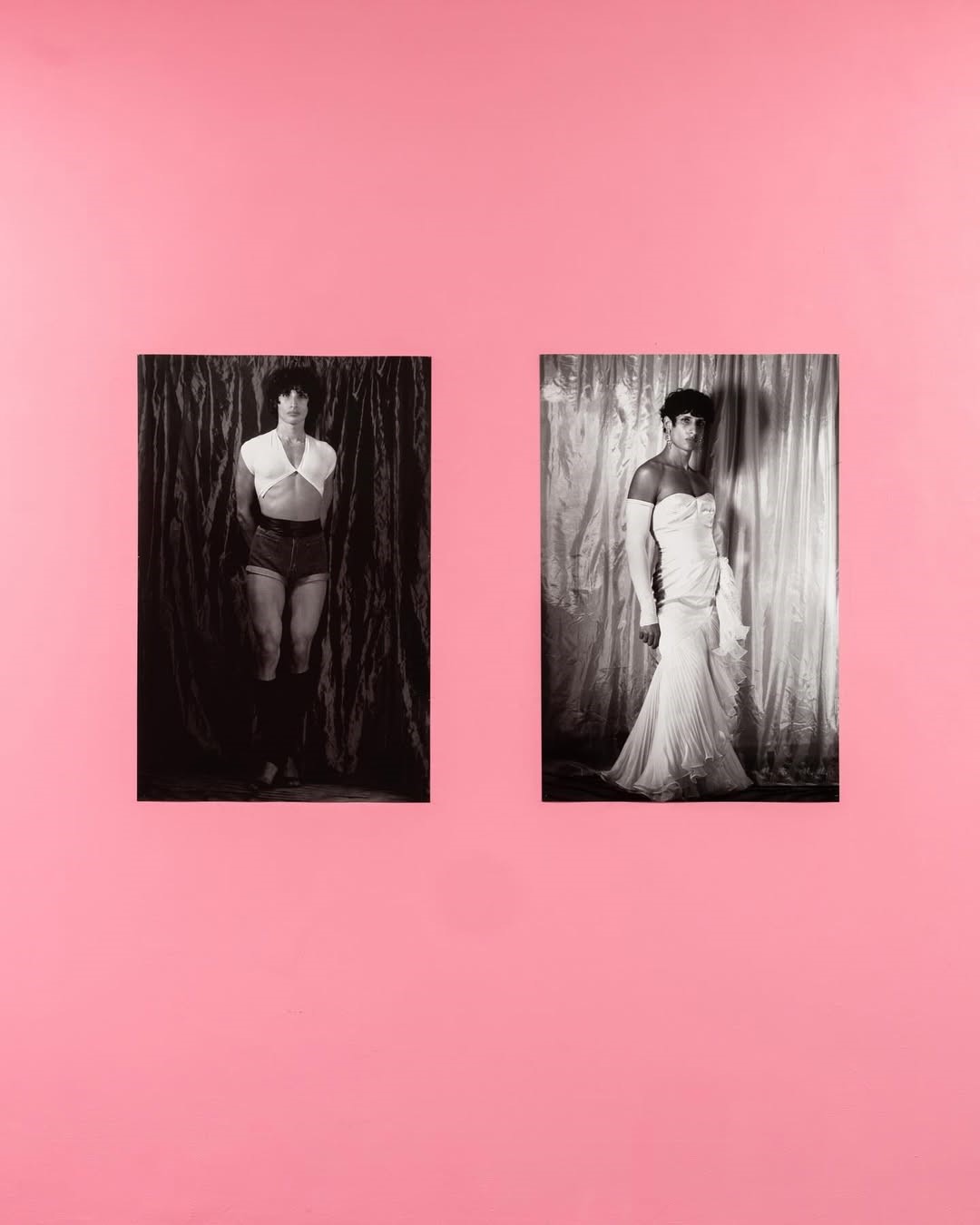
Ⓒ Fern Cerezo
Audition is another photographic work that forms a pair with Premiere. Unlike Fern in Premiere, who seems to have put immense effort into lighting, costume, makeup, and ego, Fern in Audition distinctly reveals the nervousness of an unpolished aspirant. In their artist statement, Fern compares themselves in Audition to “Audrey Hepburn, dawning from a war stricken childhood or an unrealized Norma Jean soon to be Marilyn Monroe, a survivor of foster abuse, auditioning in a Hollywood wardrobe tests.”7 It's about an innocent girl with nothing chasing her dream, becoming a star who stands at the center of a film, receives the projections of countless people's fantasies, and brings light from darkness.
As described above, the success narrative of a disadvantaged ordinary person becoming a star through an audition draws a parallel with the identity struggle of a gender-afflicted individual suffering from an inexplicable sadness, who finds their true self through gender affirmation via non-surgical/surgical transition. Fern often posts sensual selfies on Instagram, utilizing various clothing and cultural references to do so. They articulate that the goal of this ‘script re-writing’ is to “explore, accept, and document the body given to us outside of binary or gendered systems”8 and hope to “transform the bodies of queer people, often portrayed in media as a tragedy or a mockery, into an aspired status.”9
At this point, three thoughts come to my mind.
First, this is truly a remarkable practice deserving praise.
Second, in the contemporary cultural and artistic trend of incorporating and appealing to queer themes/images in one's content, Fern's work comes across as a practice to register the 'queer - body - image' approved by this era (among countless queer things) into a mainstream sexuality model.
Third, not all gender-afflicted individuals will be able to overcome their stigma by becoming a sensual model like Fern. Every individual's circumstances and way of being are different. If that's the case, how can those who can't be like Fern accept themselves and be free?
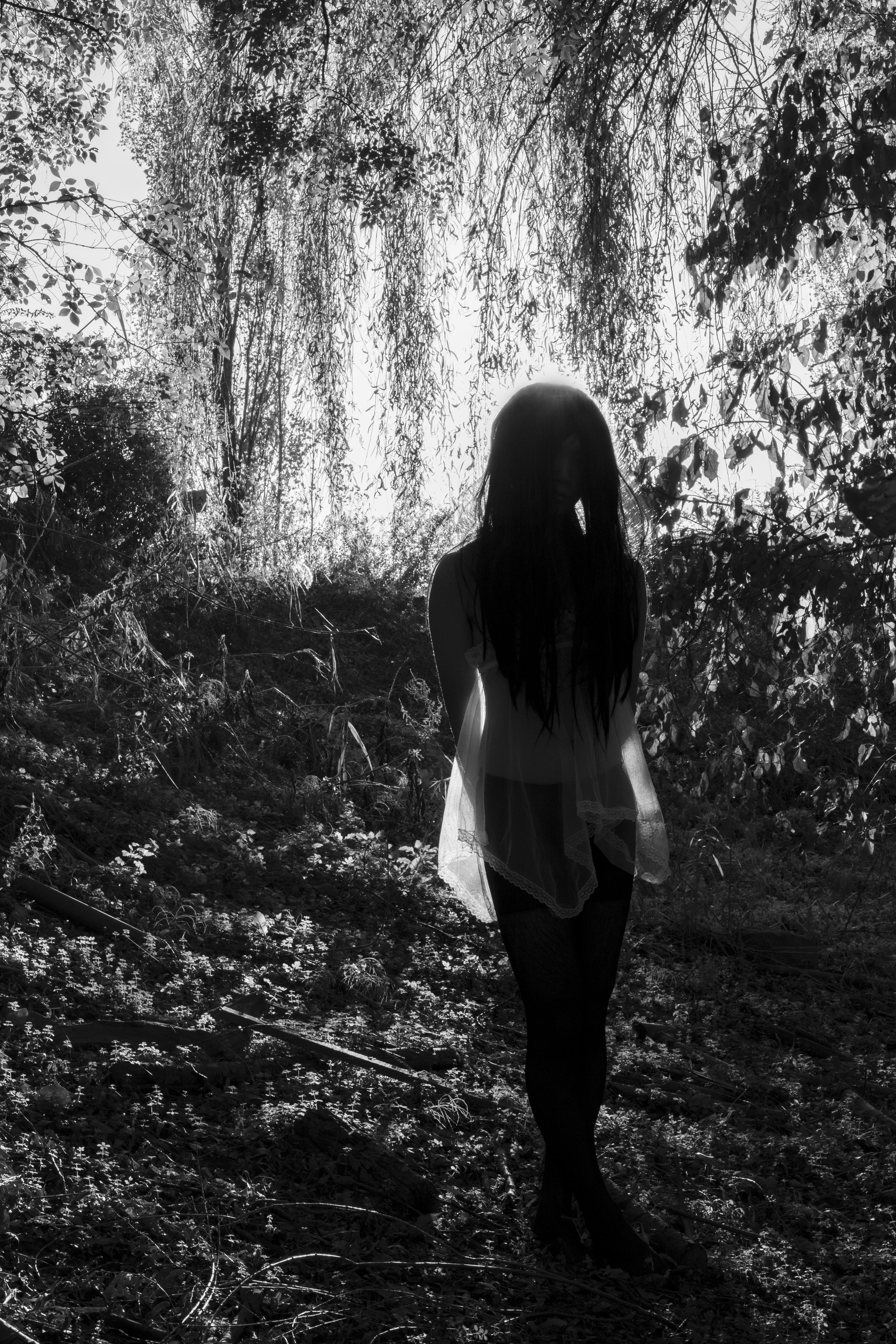
Ⓒ Jaehun
Fern Cerezo's first dream was to leave their hometown in New Jersey and move to New York. Jaehun's (1999-) first dream was to escape the boarding high school in Neungju-myeon, Hwasun-gun, Jeollanam-do, South Korea. Neungju High School, where Jaehun spent the tail end of his adolescence, was an educational institution that forced students to dedicate themselves solely to college entrance exam preparation, from waking up at 6:20 AM to going to bed at 11:00 PM. Outside the school, outings were forbidden except for a regular bi-weekly leave, and cell phone use was illegal. Although it was co-ed, the school adopted a gender-segregated class system to prevent romantic relationships from lowering grades. Three male classes and three female classes were separated by a faculty office, akin to a panopticon.
Jaehun, who involuntarily enrolled in the school, immediately sensed that something was deeply wrong after attending self-study sessions that ran until 11:00 PM on his first day. From the first semester of his freshman year, when he walked around the playground all day with like-minded peers, to the first semester of his sophomore year, when his dreams of studying abroad in the U.S. were thwarted, he constantly tried to avoid a life of slave-like exam preparation but consistently failed. He then realized he would be forced to live a life he didn't want. From that point on, Jaehun chose to exist by minimizing the presence of reality in his life.
Upon entering his sophomore year of high school, he stopped seeking out a peer group, a ritual he'd undertaken every new school year. Because the people he met in reality were always trivial and conformist, he endured each day by watching artists' creations, interviews, and pornography that he'd downloaded during sneaking out. He ignored reality. Even when his classmates, who were studying humanities, watched news and current affairs on TV, he ignored them, believing the news had nothing to do with him. He had no idea how the reality of Korea, broadcasted on the news, would come to haunt his future self.
*
The mid-to-late 2010s, when Jaehun was in high school, marked the beginning of feminism's popularization in Korea. Among young women, incidents like the Gangnam Station murder and the #MeToo movement were problematized through online platforms like social media, bringing sexual violence and discrimination, previously hushed in public spaces, into public discourse. Cases of sexual violence, long hidden beneath the surface, were exposed by numerous accusers across various sectors of society: prosecution, politics, law, business, religion, entertainment, film, theater, literature, visual art, photography, sports, and education.
For instance, Seo Ji-hyeon (1973-) is a former prosecutor who ignited the #MeToo movement by publicizing the sexual harassment she endured from her superior, Ahn Tae-geun. On January 29, 2018, she uploaded a post to prosecution services' internal Messenger network. The post contained a confession of her victimization and her hope that it would contribute to the organization's development. Stating that she chose to expose her wounds to stop such crimes from being emboldened10, she concluded her post by expressing her wish for her organization to be protected from the kind of violence she experienced. “I hope that we can stand tall as a prosecution service trusted and loved by the public, a prosecution that truly realizes justice.... I still seem to love the prosecution. To hold such an impossible hope.”
Four years later, Seo Ji-hyeon was informed of her honorary discharge without prior notice.
The lengthy list of "sectors" mentioned in the first paragraph shows us that this issue is not merely confined to the prosecution as a single organization. Power-based sexual crimes are an endemic, clandestine culture that has flourished by exploiting the hierarchical structures of most South Korean organizations, and their only demographic characteristic is that the perpetrators are typically male.11 The #MeToo movement, as a foundational event, offered victims a moment of awakening by opening up the possibility of punishing past silenced violence, and it branded "men" with the label of “potential perpetrators.”
*
At the time, Jaehun, immersed in his studies in a rural village far from the city, considered the news about gender issues swirling through various media and broadcasting companies irrelevant to him. However, the university community he entered after finishing his exams was already under the immense aftermath of that storm. For Jaehun, who had only been around male students in high school, the many female students he met in college were somewhat unfamiliar, and even after becoming friends, they made him feel a sense of unease. It didn't take long for him to realize that one of the causes of this unease was the history of violence created by those who shared his "male" identity.
News that a poet he admired had asked his student, "If sleeping with me makes your poetry better, would you sleep with me?" or that a highly acclaimed film director had repeatedly sexually assaulted lead and supporting actresses under the guise of production, were not infrequent enough to dismiss as mere coincidences. Confused, Jaehun tried to ignore these numerous incidents, telling himself he was just unlucky. It felt like self-negation to cut himself off from the (male) artists who had been friends and true teachers, and a source of comfort, hope during his lonely high school years.
However, as he was continuously exposed to stories of male classmates being cut off by female students, or his own pathetic self coming to light when he was with close friends, he found it harder not to view the male gender as the root of all evil and an object of contempt. The fear that he would become no different from the perpetrators mentioned earlier, once he reached a position of power in his older age, grew over time.
Facing a crisis of identity, Jaehun began to research where this injustice he was experiencing originated. This was his only option besides entrusting himself to artists who had been exposed as false heroes. In this process, he became deeply interested in and studied feminism, the origin of the #MeToo movement, which symbolically "killed" his idols. He realized that the personal difficulties he had experienced were, in fact, born out of a long-standing structure of discrimination and exploitation.12 This realization prompted him to decide to escape from the identity of 'male' and the history of violence it embodies, which had been imposed upon him.
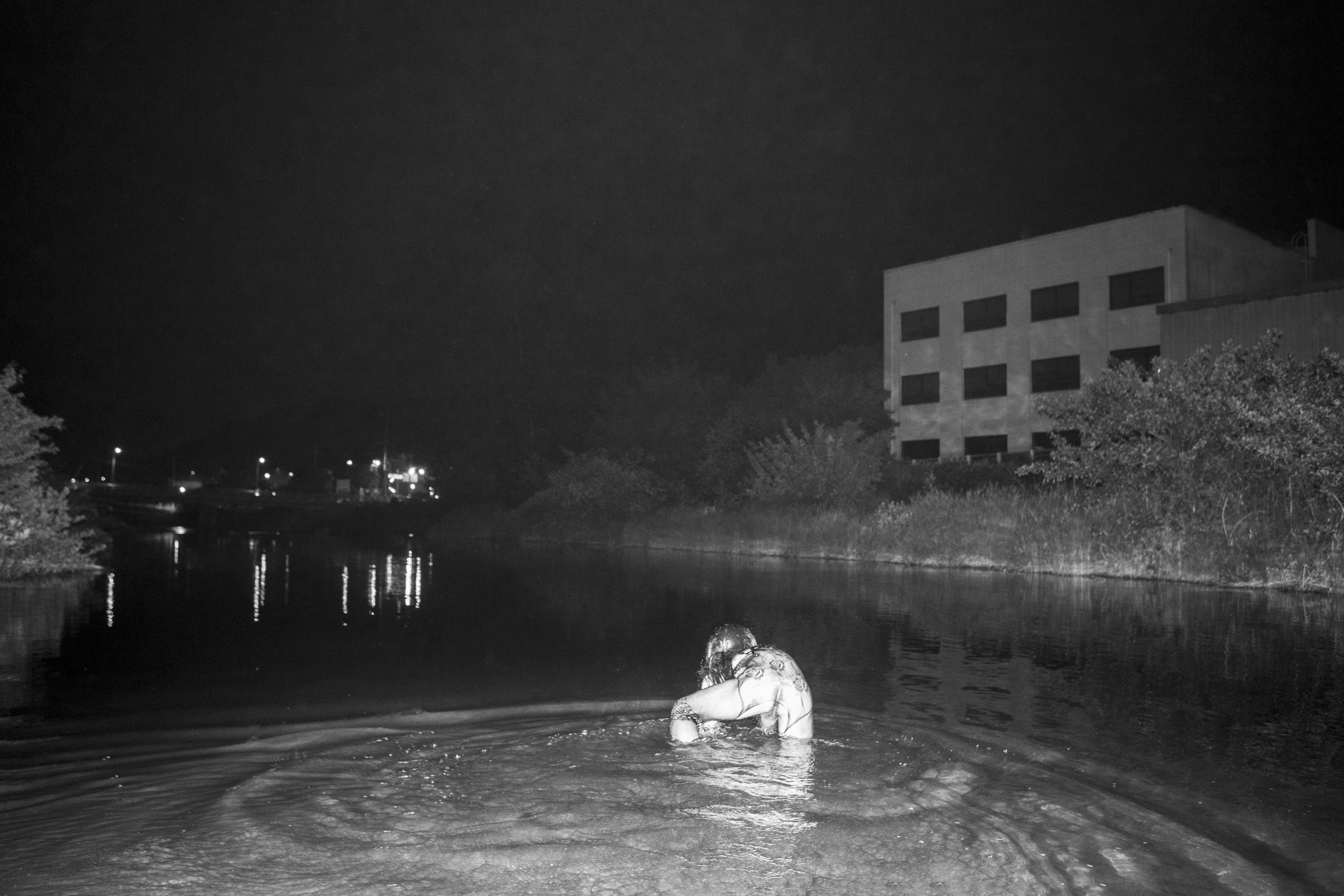
Ⓒ Jaehun
For those who undertake voluntary disappearance because they cannot bear the conditions of life that form their identity, for those who erase their names and abscond in the dead of night, their post-lives diverge into three paths: living anonymously, adopting a new name, or stealing another's name. Jaehun's goal was an ontological migration through the abandonment of male identity, and to achieve this, he delves into sexuality, the very source of pornography and sexual violence that he had continuously tried to look away.
Among several series created in the trajectory of his escape, The Countenance of an Old Beauty is a self-portrait Jaehun photographed in 2023. In contrast to Fern in Premiere, where the subject's features are reproduced with high resolution, the portrait of the figure in The Countenance of an Old Beauty, shot against the light, is filled with deep shadows. Standing in a dense forest of trees and leaves, she reveals herself only through the silhouette of long straight hair and a demure posture, and a thin, white cloth top.
The beautiful photograph could easily be interpreted as a utopian conclusion: Jaehun, plagued by male guilt and gender dysphoria, is reborn as an anonymous woman. However, as An Chorong points out, the fact that the transformation target is a young girl in her teens or early twenties creates a mysterious sense of déjà vu that makes it difficult to view this story as a simple fantasy fairy tale.13 Joo Amyong, in her critic "Rest," deduces the true nature of this déjà vu, noting that the external model for Jaehun in The Countenance of an Old Beauty was a sex doll.14 In fact, the white top visible in the photo is lingerie that is part of a sex doll's ensemble. Before arriving at the forest where the shoot took place, he exchanged his clothes with the doll's clothes in a motel room, as if to say he would take on the doll's role himself.15
Historically, "woman" has been synonymous with the Other, sex workers were a profession created to fill the gaps in patriarchy, and sex dolls are their modern substitute. If one understands all these roles as sacrifices, possessions, and slaves necessary for the male subject to realize his desires, then in The Countenance of an Old Beauty, Jaehun manifests himself as evidence of his own guilt. Is this atonement for the male sin he tried to ignore, or the manifestation of a dormant, non-normative sexual fantasy?16
To answer the above question, let's look at the photo once more. The Countenance of an Old Beauty is a vertical photograph within a rectangular frame, densely packed with countless plants. If each leaf forming the background is a metaphor for a single man, then Jaehun in the photo is taking on the role of a woman being chased by numerous men (including himself). In that case, that black-and-white quagmire is a space of freedom created by his desire to solve his guilt by mending it into a fetish.
[1] Raymond Sokolov, “Critique: Censoring Virginia”, The Wall Street Journal, 6 February 1991, p. A10.
[2] Richard B. Woodward, “The Disturbing Photography of Sally Mann”, The New York Times, September 27, 1992, Section 6, Page 29. https://www.nytimes.com/1992/09/27/magazine/the-disturbing-photography-of-sally-mann.html?smid=url-share
[3] Blood Ties: The Life and Work of Sally Mann, Steven Cantor & Peter Spirer, Moving Target Productions, 4 March 1994.
[4] Ibid.
[5] A text that Fern posted on Instagram with Premiere https://www.instagram.com/p/DCmloApvUBh/?utm_source=ig_web_copy_link.
[6] Devan Díaz, “Fern and the city”, Dirt, 30 Nov 2023, https://dirt.fyi/article/2023/11/fern-and-the-city.
[7] A text that Fern posted on Instagram with Audition. https://www.instagram.com/p/DCPcdatvHHc/?utm_source=ig_web_copy_link.
[8] The artist's expressions from emails exchanged with the author.
[9] Part of the description of Fern’s self-portrait on their website, https://www.ferncerezo.com/about.
[10] Seo Ji-hyun re-cited a quote from Albert Camus in her post, Hwang Chun-hwa, "[Full Text] Prosecutor Seo Ji-hyun's Exposé of Ahn Tae-geun's Sexual Harassment," January 30, 2018 https://www.hani.co.kr/arti/society/society_general/830046.html#ace04ou
[11] Jeong Hee-jin, "Violence Against Women and the MeToo Movement," The Politics of MeToo, p. 87, Gyoyang-in, 2019
[12] Ahn Dahm, "Ten Thousand Women," The look, p. 191, Wisdom House, 2024
[13] An Chorong & Jaehun, "Review of The Old Room is a Palace w. An Chorong," One Action One Day, 2025, https://oneactiononeday.com/subpage/inthecastle_question.html
[14] A sex doll is a type of adult product, an effigy in the size and shape of a sexual partner. Also commonly known as a "love doll" or "real doll," its primary purpose is to serve as a sexual partner. It can consist of body parts designed for sexual stimulation as well as a torso and other body parts. Specific preparation processes can be added, such as dressing them in various types of clothing, changing their wigs or adjusting their makeup, and even using electric blankets or baths to match their temperature to that of the human body. Sources: Wikipedia, Namu Wiki.
[15] Joo Amyong, "Rest," The Old Room is a Palace, Tank Press, scheduled for publication in 2025
[16] Han sol has stated that she understands Jaehun's photo series as a product imbued with the artist's rape fantasies. Seunga You, Jaehun, Han sol, and Yezoi Hwang, "The Old Room is a Palace Review," The Old Room is a Palace, to be published in 2025.
About the artist
Jaehun
Jaehun creates self-portraits that project himself into the cultural landscape of the community. He explores post-feminist male sexuality through the mediums of photography and installation. As part of this ongoing process, he participated in the group exhibition “The Motel : Because I want to live there” (2023, Misungjang Motel, Seoul) and held a solo exhibition "The Old Room is a Palace" (2024, Ian DoDream, Yongin). Believing that art is a medium for conversation, he also runs the exhibition review project 'One Action One Day'.
oneactiononeday.com
Depot
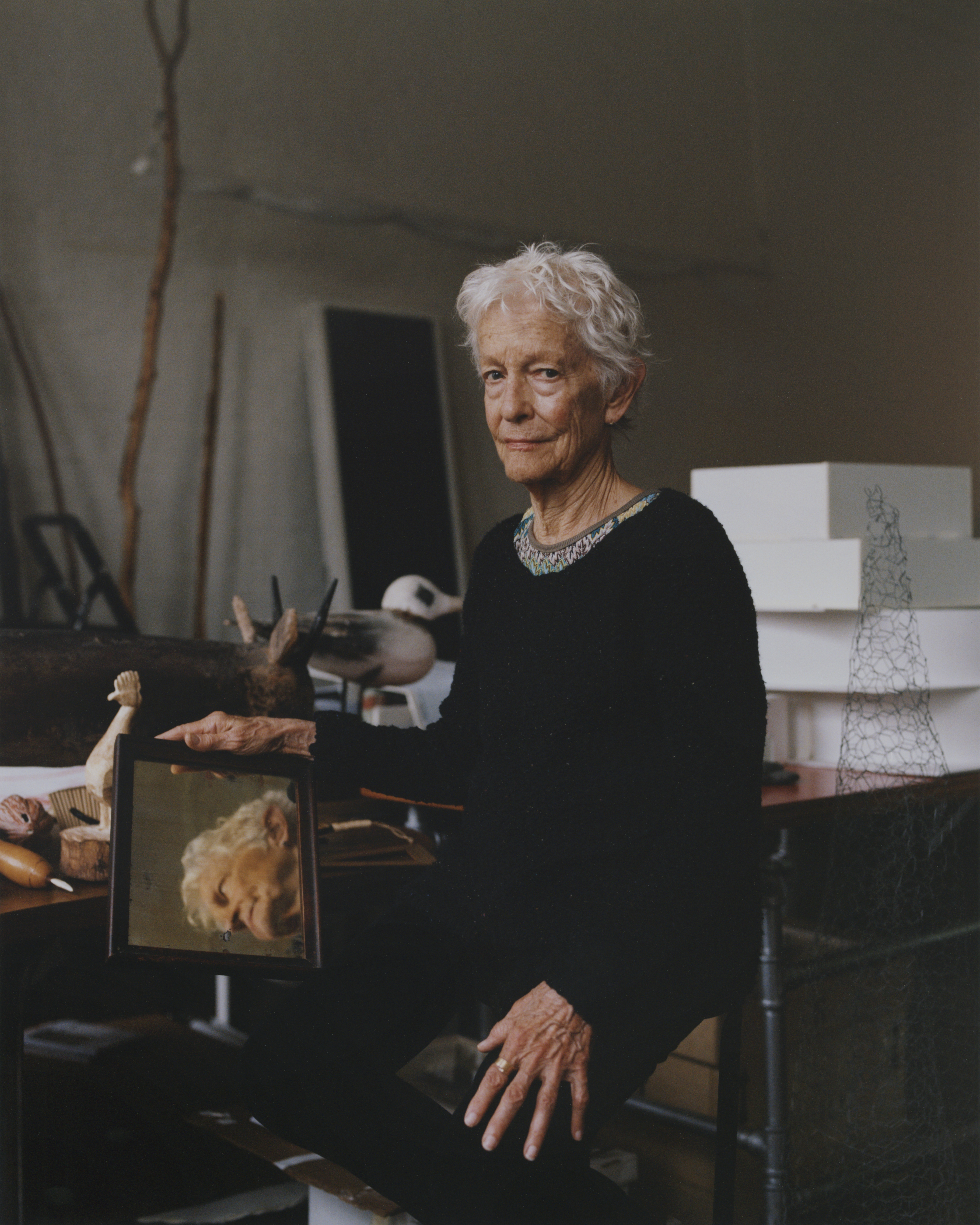
Joan Jonas (1936-)
Joan Jonas is an American visual artist and a pioneer of video and performance art. Her works, which emerged from her studies in literature and sculpture, combined with a passion for film, led her to be one of the first to experiment with performance art. One of her representative works, Mirror Piece, is a performance piece that utilizes images created by performers holding mirrors to reveal the performers, the audience, and the space they stay in.
Joan has loved dogs since childhood. She lives with them, draws them, and features them in her performances and videos.
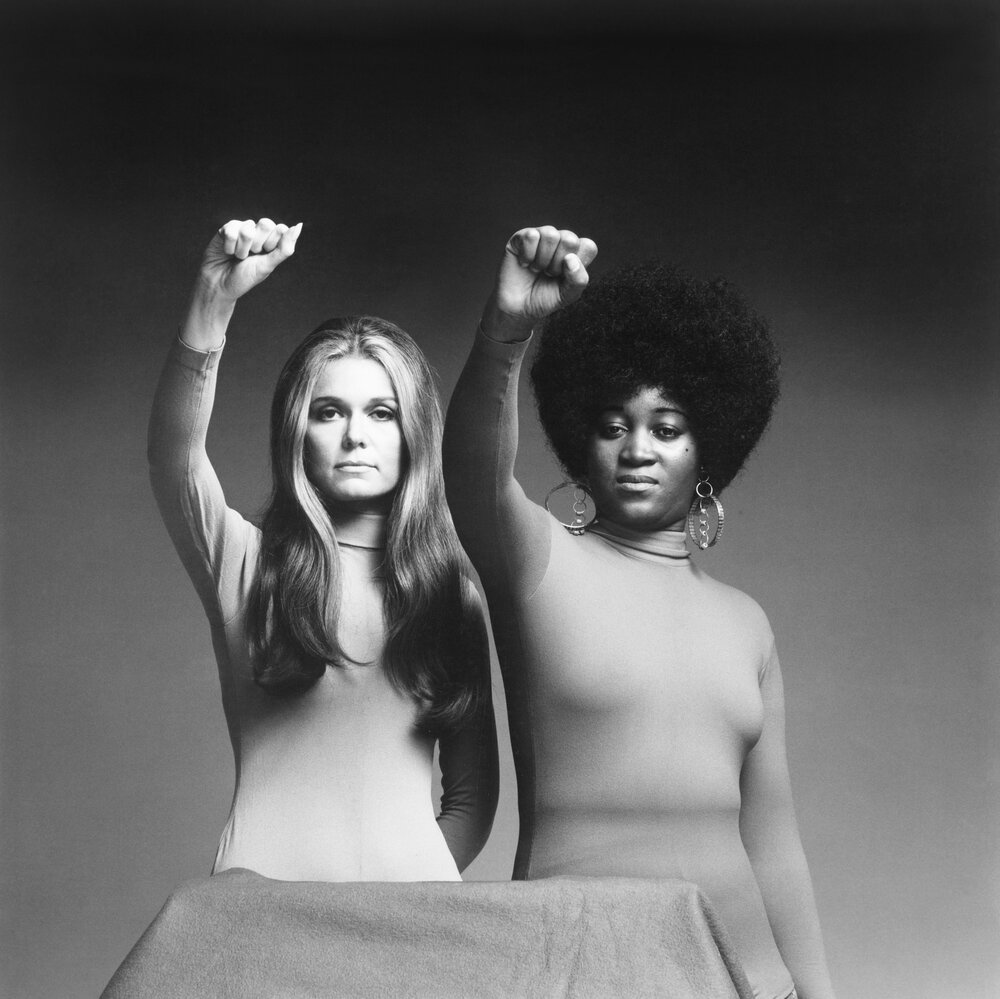
Gloria Steinem (1934-)
Gloria Steinem (left) is an American-born and raised feminist. She grew up with a father who lived out of his car and earned a living by reselling antiques on the street, and a mother who, in his stead, bore the brunt of all worries. After graduating from college, she worked as a journalist and social activist. She gained recognition by going undercover as a Bunny at the Playboy Club and writing the article A Bunny's Tale, exposing the unreasonable working conditions and sexist treatment faced by women working there. She also co-founded the pioneering feminist magazine Ms., which addressed women's perspectives and issues, and Ms. became a crucial platform for the Second-Wave Feminist movement.
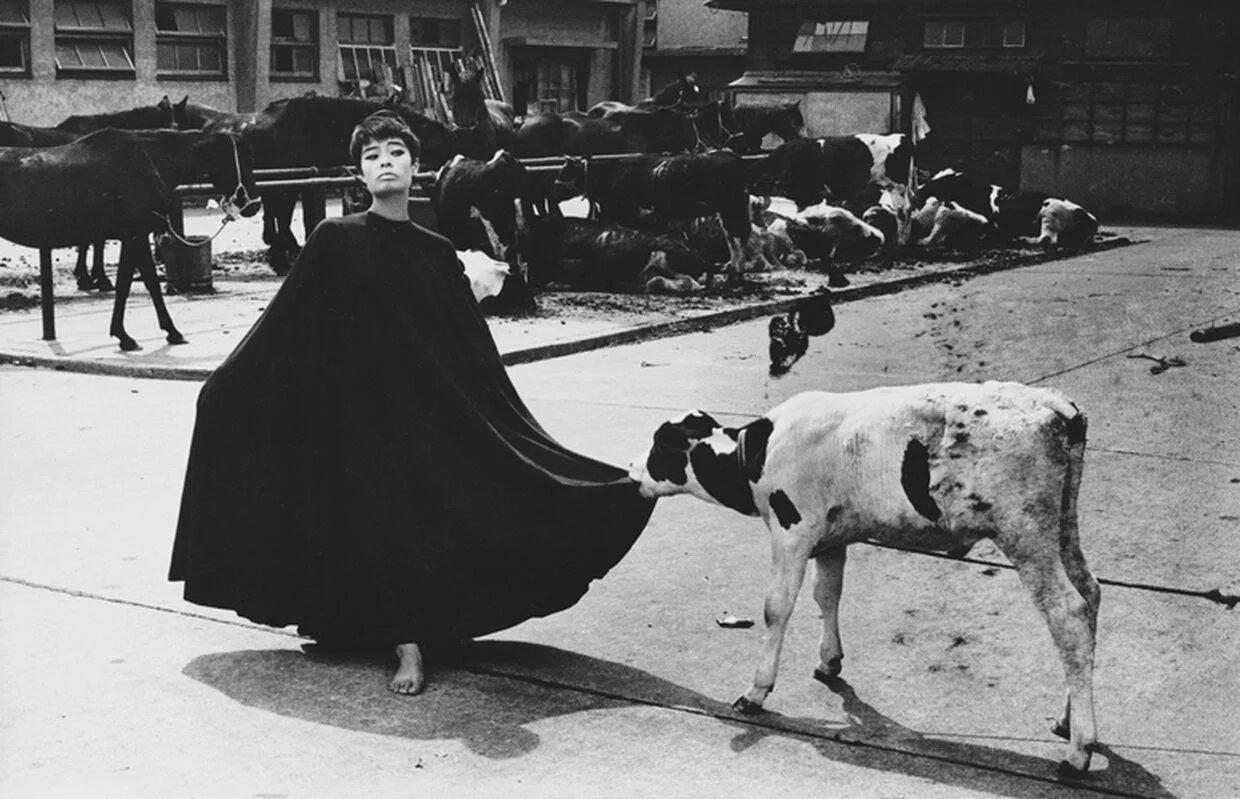
Yukiyo Kawakami (Undated)
Yukiyo Kawakami (left) was the first wife of Japanese photographer Masahisa Fukase. They lived together for eight years and had two children, though their first child was stillborn. Fukase then photographed the stillborn child and exhibited the print in his first solo exhibition, Kill the Pig. She was also a subject and muse for Fukase's early photographic works.
In 1962, Kawakami left Fukase with their second child and disappeared.
Translated by Gemini, Reviewed by Hosung Choo, Jaehun

